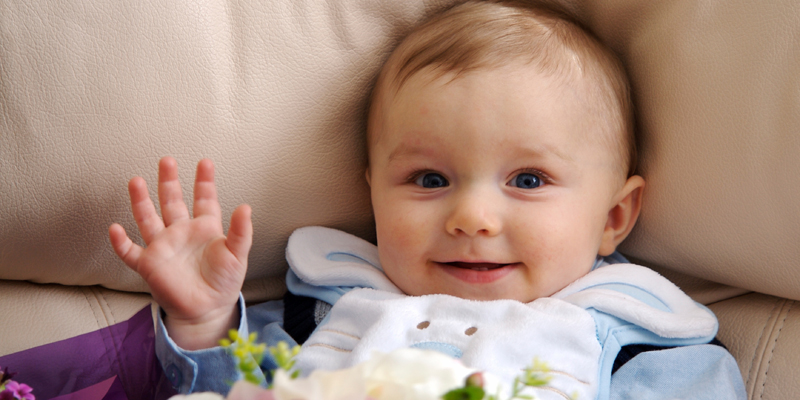
Language Skills Milestone: Talking with Gestures
Try blowing a raspberry at your baby–stick out your tongue and blow air across it, producing a spitting sound–and see what kind of response you get! You’ll most likely find her watching you with an interested look, then giggling and attempting to blow bubbles, too. Wave to your baby when you say hello, and you may see her attempting to wave her own hand. Talking with gestures like these creates interest and develops understanding. At 6-9 months, babies try to communicate primarily through imitation as they actively copy speech and other common sounds.1
(SPECIAL OFFER: Sign up for Playful Bee’s Bee Well developmental learning program to give your baby the best start in life. The first 10,000 children enroll for FREE! Sign up today.)
Your baby may also move a step past imitation and begin to use specific sounds to identify objects and people. For example, you may hear her shouting “Dah!” when daddy comes home or saying “Bah” when pointing to her bottle.
In addition, you should see your baby develop her Gesture Language skills, copying the actions and gestures you use often, such as waving good-bye.2 While she may not necessarily understand why she is waving at this point, she will soon learn that this action says “good bye!” to someone who is leaving. Other common gestures used by babies at this age include blowing kisses, giving high-fives, throwing hands up as in saying “Ta-Dah,” and pointing to desired objects. Pay as much attention to your baby’s body gestures as you would to a spoken request. The more successful she feels in communicating, the more likely it is that she will stay motivated to keep communicating and the less frustrated she’ll be.3
Consider teaching her some baby signs to help her better communicate needs.4 You can use the ones that are commonly in use, or make up ones that feel natural to you. Some of the words most people start with include “more,” “milk,” “book,” “done,” “eat,” and her favorite foods.5 The Mayo Clinic advises that you start any time, but realize your baby most likely won’t be able to sign back until about eight months.4 In addition, be patient and encourage her attempts to gesture or sign, remembering that the end goal is reduced frustration, not a child fluent in American Sign Language!
Play Tips:
Do you want to know how you can support your baby’s development of these Gesture Language skills at this age? It’s easy! Read on for some simple tips to incorporate into your daily play time together.
- Introduce basic sign language and gestures for common words.1 Using simple signs for commonly used words and expressions, such as “I love you,” “hungry,” “milk,” “more,” “eat,” and “nap,” will empower your baby to communicate even before she is ready for verbal language. Learning useful gestures will help her let you know her needs and reduce frustrations and tears. While many parents use American Sign Language (ASL) as the basis for the “baby signs” they use at home, you can create your own signs if you choose. Just be sure to keep your signs simple and consistent.
- Repeatedly say the word or words for each gesture you use. Boost your baby’s verbal Expressive Language development by saying the actual words for every gesture and action either of you makes.
(SPECIAL OFFER: Sign up for Playful Bee’s Bee Well developmental learning program to give your baby the best start in life. The first 10,000 children enroll for FREE! Sign up today.)
Developmental Milestones:
Has your baby achieved the following Gesture Language developmental milestones yet? If yes, check off all the skill(s) he has already mastered to date using Playful Bee’s developmental milestones tracker. It’s absolutely FREE and easy to use, just click HERE!
- Imitates sounds and gestures of others (e.g. waving, blowing kisses).
Sources:
1Maryland State Department of Education (2010). Healthy Beginnings: Supporting Development and Learning from Birth through Three Years of Age.
2Ohio Child Care Resource and Referral Association (2006). Ohio’s Infant Toddler Guidelines.
3Sterling Honig, Alice. Infants and Toddlers: How Babies Use Gestures to Communicate. Early Childhood Today. Retrieved December 15, 2013 from http://www.scholastic.com/teachers/article/infants-toddlers-how-babies-use-gestures-communicate-0.
4Hoecker, Jay L. (2013). Is Baby Sign Language Worthwhile? Mayo Clinic: Infant and Toddler Health – Expert Answers. Retrieved September 24, 2014, from http://www.mayoclinic.org/healthy-living/infant-and-toddler-health/expert-answers/baby-sign-language/faq-20057980.
5Lauren Passell (2014). Baby Sign Language: 21 Words and Signs to Know. Parenting. Retrieved September 24, 2014, from http://www.parenting.com/gallery/baby-sign-language-words-to-know?page=20.
Acredolo L, and Goodwyn S. (1988). Symbolic Gesturing in Normal Infants. Child Development, 59(2): 450-466.
Playful Bee
Latest posts by Playful Bee (see all)
- Have a Super Fortune Cookie Friday! - February 9, 2018
- All Kinds of Shapes: Your Child Is Learning Simple Shapes, and Drawing Them Too! - November 13, 2017
- Fishing for Sneakers: Create your own Hand-Eye Coordination Fun - November 11, 2017

+ There are no comments
Add yours